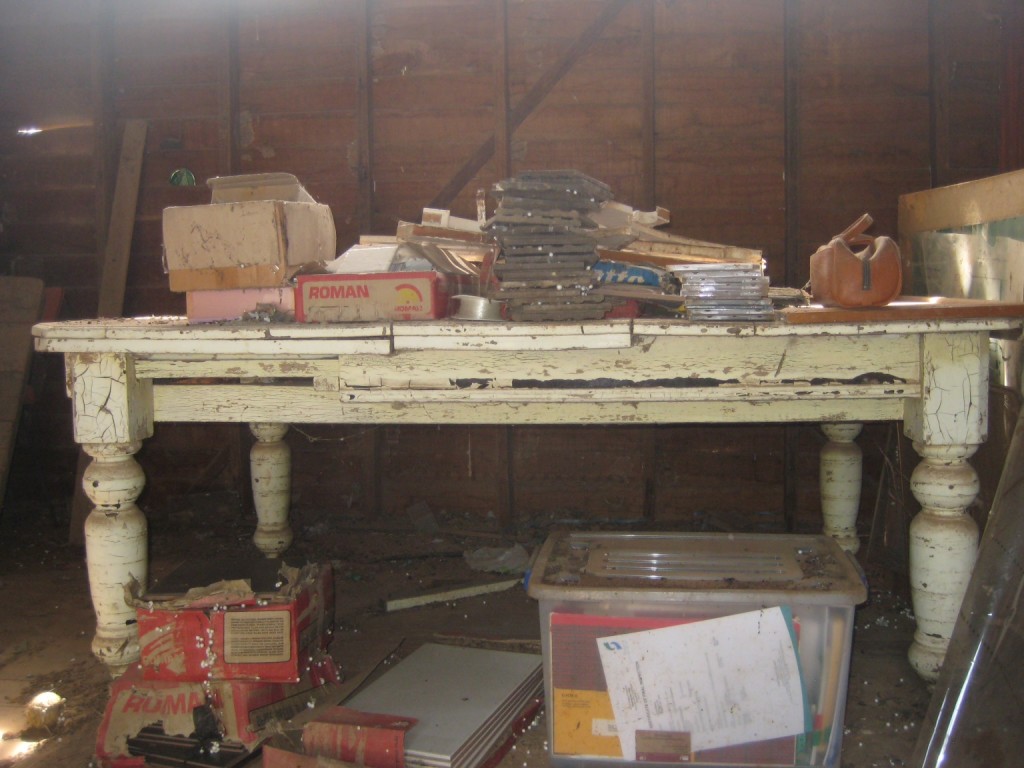One of our church members, who I’ll call Jim, has been having a clean out. Not just your run of the mill, “We have too much stuff” type of cleanout, but the one you have when you sell up the family farm and there is 90 years of “This will be useful one-day” and “This cost a lot of money in its day” and “We have two sheds full of this stuff.” They had a clearing sale of course but there is always some stuff that doesn’t ’t sell or is considered to be not worth selling.
So that’s where I came in. I love old stuff and I’ve still got a few places to store or display it. My attitude to such stuff is that once it is gone you’ll never see the like of it again, so if it isn’t a health hazard, or breeding vermin, or going to fall down and kill someone, it’s a fashion statement. And I’m not into minimalism!
 So I was offered this old table. It had been bought secondhand by Jim’s father at a clearing sale in 1948. It’s an old wooden dining table with turned legs. It has thick white paint, peeling and blistered on its legs and sides, but the top is bare wood; his father had tacked lino on the top to make it a durable family kitchen table. Somewhere along the way the table had been moved into the shed and fell into disuse. The top is split and somewhat warped. I love it! I told Jim, I would fix it up, but probably leave the peeling paint.
So I was offered this old table. It had been bought secondhand by Jim’s father at a clearing sale in 1948. It’s an old wooden dining table with turned legs. It has thick white paint, peeling and blistered on its legs and sides, but the top is bare wood; his father had tacked lino on the top to make it a durable family kitchen table. Somewhere along the way the table had been moved into the shed and fell into disuse. The top is split and somewhat warped. I love it! I told Jim, I would fix it up, but probably leave the peeling paint.
So we loaded it into the ute. As we drove the stories and memories that were embedded in the table began to leak out. Before we had arrived at the shed just the idea of the table triggered memories but the act of touching and being close to the old table as we dusted it down, lifted it and sent it on the next part of its journey brought back vivid memories for Jim of family meals, of his mother and father, his brothers and sisters. Seventy years on he still knew where he sat. He remembered the feel of the lino and the taste of his mother’s cooking. Listening to his stories brought back memories for me too. The feel of a brother’s shoulder as eight of us squeezed around our family table.
So many memories are embodied in the things and objects we surround ourselves with. In a museum we can see many objects like the objects of our childhood, but museums are all “Look, but don’t touch” sort of places. Photos are great, but there is something about touching things; the shape, the texture, the weight and warmth or coldness of objects that provide access to deep memories. There is a power in such experiences that takes us beyond remembering to “feeling it in our bones”.
One of the central traditions of Christian worship is remembering. The act of communion is an active and participatory remembering as we pass the peace, sing, pray, eat and remember. This touching and eating around the table remembering was captured in the Apostle Paul’s familiar words:
“For I received from the Lord what I also passed on to you: The Lord Jesus, on the night he was betrayed, took bread, and when he had given thanks, he broke it and said, ‘This is my body, which is for you; do this in remembrance of me.’ In the same way, after supper he took the cup, saying, ‘This cup is the new covenant in my blood; do this, whenever you drink it, in remembrance of me.’.”
1 Corinthians 11:23-26
This sort of remembering isn’t about recalling the information for an exam or trying to think of where you left your house keys. It’s more like Jim’s memories of family meals and a table. This sort of remembering has the power to move us and speaks of grace and love that we can feel in our bones.
This is the gospel and it’s good news.
Brian Spencer, Minister
